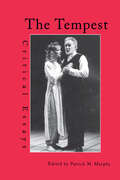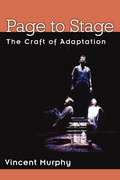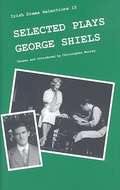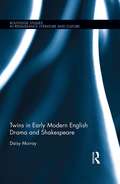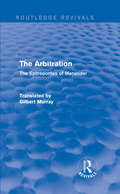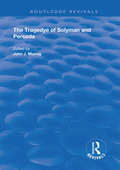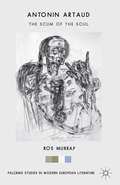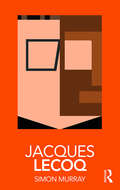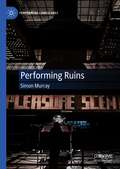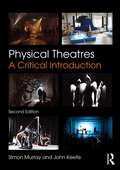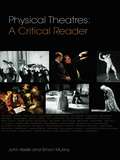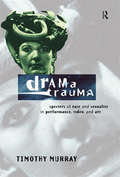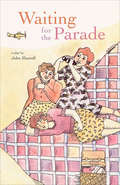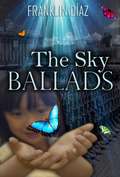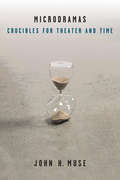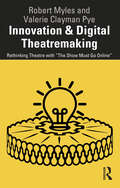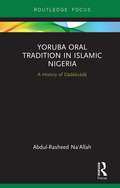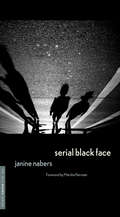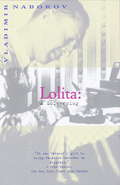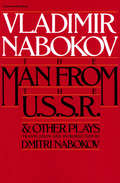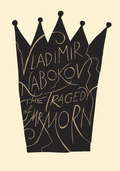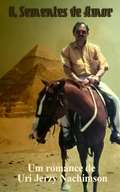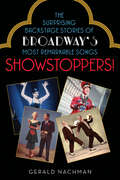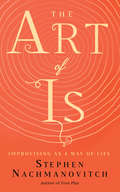- Table View
- List View
The Tempest: Critical Essays (Shakespeare Criticism #Vol. 21)
by Patrick M. MurphyThe Tempest: Critical Essays traces the history of Shakespeare's controversial late romance from its early reception (and adaptation) in the seventeenth and eighteenth centuries to the present. The volume reprints influential criticism, and it also offers eight originalessays which study The Tempest from a variety of contemporary perspectives, including cultural materialism, feminism, deconstruction, performance theory, and postcolonial studies. Unlike recent anthologies about The Tempest which reprint contemporary articles along with a few new essays, this volume contains a mixture of old and new materials pertaining to the play's use in the theater and in literary history.
Page to Stage: The Craft of Adaptation
by Vincent MurphyAt last, for those who adapt literature into scripts, a how-to book that illuminates the process of creating a stageworthy play. Page to Stage describes the essential steps for constructing adaptations for any theatrical venue, from the college classroom to a professionally produced production. Acclaimed director Vincent Murphy offers students in theater, literary studies, and creative writing a clear and easy-to-use guidebook on adaptation. Its step-by-step process will be valuable to professional theater artists as well, and for script writers in any medium. Murphy defines six essential building blocks and strategies for a successful adaptation, including theme, dialogue, character, imagery, storyline, and action. Exercises at the end of each chapter lead readers through the transformation process, from choosing their material to creating their own adaptations. The book provides case studies of successful adaptations, including The Grapes of Wrath (adaptation by Frank Galati) and the author's own adaptations of stories by Samuel Beckett and John Barth. Also included is practical information on building collaborative relationships, acquiring rights, and getting your adaptation produced.
Selected Plays: George Shiels
by Christopher MurrayContains The Retrievers (hitherto unpublished), Professor Tim, The New Gossoon, The Passing Day, The Rugged Path, and The Summit, bibliographical checklist. George Shiels (1886-1949) was one of the most prolific and most successful playwrights in the history of the Abbey Theatre. Before his debut at the Abbey, Shiels's early work was staged by the Ulster Literary Theatre in Belfast and later on his work was taken up by the dynamic Group Theatre, also in Belfast. As a Northerner, Shiels embraced the whole island in his work, his use of dialect and his characterisation. Moreover, while his plays were broadly popular and wonderfully well suited to the acting talents of theatre companies North and South, his all-Ireland perspective lent his work a keen critical edge masked by easy realism and hilarious comedy. Nowadays, we turn to the dark comedy of a play like The Passing Day to re-adjust our view of Shiels and to see his plays as seriously concerned with the land question and issues of identity, gender and the law in post-colonial Ireland. From that perspective, The New Gossoon and in particular The Rugged Path (which in 1940 broke all previous box-office receipts at the Abbey, when the production played for an unprecedented twelve weeks, all previous plays having been limited to two) challenge us to look again at Shiels and see him as public commentator as well as consummate entertainer.
Twins in Early Modern English Drama and Shakespeare (Routledge Studies in Renaissance Literature and Culture)
by Daisy MurrayThis volume investigates the early modern understanding of twinship through new readings of plays, informed by discussions of twins appearing in such literature as anatomy tracts, midwifery manuals, monstrous birth broadsides, and chapbooks. The book contextualizes such dramatic representations of twinship, investigating contemporary discussions about twins in medical and popular literature and how such dialogues resonate with the twin characters appearing on the early modern stage. Garofalo demonstrates that, in this period, twin births were viewed as biologically aberrant and, because of this classification, authors frequently attempt to explain the phenomenon in ways which call into question the moral and constitutional standing of both the parents and the twins themselves. In line with current critical studies on pregnancy and the female body, discussions of twin births reveal a distrust of the mother and the processes surrounding twin conception; however, a corresponding suspicion of twins also emerges, which monstrous birth pamphlets exemplify. This book analyzes the representation of twins in early modern drama in light of this information, moving from tragedies through to comedies. This progression demonstrates how the dramatic potential inherent in the early modern understanding of twinship is capitalized on by playwrights, as negative ideas about twins can be seen transitioning into tragic and tragicomic depictions of twinship. However, by building toward a positive, comic representation of twins, the work additionally suggests an alternate interpretation of twinship in this period, which appreciates and celebrates twins because of their difference. The volume will be of interest to those studying Shakespeare and Renaissance Literature in relation to the History of Emotions, the Body, and the Medical Humanities.
The Arbitration: The Epitrepontes of Menander (Routledge Revivals)
by Gilbert MurrayGilbert Murray translated and made available to modern readers The Epitrepontes of Menander or The Arbitration for the first time in 1945. The Arbitration is among the most frequently quoted and most famous of Menander’s plays and – being less farcical than others - belongs to his mature style. With an interesting and informative introduction, this translation will be of value to any student of Classics and Ancient Greek drama.
The Tragedye of Solyman and Perseda: Edited from the Original Texts with Introduction and Notes (Routledge Revivals)
by John J. MurrayPublished in 1991 The Tragedye of Solyman and Perseda is a late Elizabethan romantic tragedy by Thomas Kyd, author of The Spanish Tragedy. It dramatises the triangular relationship of the Turkish emperor Soliman, his captive Perseda and her beloved Erastus against the fictionalised backdrop of the Turkish invasion of Rhodes in the early sixteenth century. This volume contains the original text along with textual and critical notes.
Antonin Artaud: The Scum Of The Soul (Palgrave Studies in Modern European Literature)
by Ros MurrayThis book serves as analysis of the aesthetics of materiality in the multifaceted work of Antonin Artaud, one of Twentieth-Century France's most provocative and influential figures, spanning literature, performance, art, cinema, media and critical theory.
Jacques Lecoq (Routledge Performance Practitioners)
by Simon MurrayThis volume offers a concise guide to the teaching and philosophy of one of the most significant figures in twentieth century actor training. Jacques Lecoq's influence on the theatre of the latter half of the twentieth century cannot be overestimated. Now reissued Jacques Lecoq is the first book to combine: an historical introduction to his life and the context in which he worked an analysis of his teaching methods and principles of body work, movement, creativity, and contemporary theatre detailed studies of the work of Theatre de Complicite and Mummenschanz practical exercises demonstrating Lecoq's distinctive approach to actor training.
Performing Ruins (Performing Landscapes)
by Simon MurrayThis book engages with the relationship between ruins, dilapidation, and abandonment and cultural events performed within such spaces. Following the author’s fieldwork in the UK, Bosnia Herzegovina, Poland, Germany, Greece, and Sicily, chapters describe, investigate, and reflect upon live performance events which have taken place in sites of decay and abandonment. The book’s main focus is upon modern economic ruins and ruins of warfare. Each chapter provides several case studies based upon the author’s own site visits and interviews with actors, directors, producers, curators, writers, and other artists. The book contextualises these events within the wider framework of Ruin Studies and provides brief summaries of how we might understand the ruin in terms of time, politics, culture, and atmospheres. The book is particularly preoccupied with artists’ reasons and motivations for placing performance events in ruined spaces and how these work dramaturgically.
Physical Theatres: A Critical Introduction
by Simon Murray John KeefeThis new edition of Physical Theatres: A Critical Introduction continues to provide an unparalleled overview of non-text-based theatre, from experimental dance to traditional mime. It synthesizes the history, theory and practice of physical theatres for students and performers in what is both a core area of study and a dynamic and innovative aspect of theatrical practice. This comprehensive book: traces the roots of physical performance in classical and popular theatrical traditions looks at the Dance Theatre of DV8, Pina Bausch, Liz Aggiss and Jérôme Bel examines the contemporary practice of companies such as Théatre du Soleil, Complicite and Goat Island focuses on principles and practices in actor training, with reference to figures such as Jacques Lecoq, Lev Dodin, Philippe Gaulier, Monika Pagneux, Etienne Decroux, Anne Bogart and Joan Littlewood. Extensive cross references ensure that Physical Theatres: A Critical Introduction can be used as a standalone text or together with its companion volume, Physical Theatres: A Critical Reader, to provide an invaluable introduction to the physical in theatre and performance. New to this edition: a chapter on The Body and Technology, exploring the impact of digital technologies on the portrayal, perception and reading of the theatre body, spanning from onstage technology to virtual realities and motion capture; additional profiles of Jerzy Grotowski, Wrights and Sites, Punchdrunk and Mike Pearson; focus on circus and aerial performance, new training practices, immersive and site-specific theatres, and the latest developments in neuroscience, especially as these impact on the place and role of the spectator.
Physical Theatres: A Critical Reader
by Simon Murray John KeefePhysical Theatres: A Critical Reader is an invaluable resource for students of physically orientated theatre and performance. This book aims to trace the roots and development of physicality in theatre by combining practical experience of the field with a strong historical and theoretical underpinning. In exploring the histories, cross-overs and intersections of physical theatres, this critical Reader provides: six new, specially commissioned essays, covering each of the book’s main themes, from technical traditions to contemporary practises discussion of issues such as the foregrounding of the body, training and performance processes, and the origins of theatre in both play and human cognition a focus on the relationship and tensions between the verbal and the physical in theatre contributions from Augusto Boal, Stephen Berkoff, Étienne Decroux, Bertolt Brecht, David George, J-J. Rousseau, Ana Sanchez Colberg, Michael Chekhov, Jeff Nuttall, Jacques Lecoq, Yoshi Oida, Mike Pearson, and Aristotle.
Drama Trauma: Specters of Race and Sexuality in Performance, Video and Art
by Timothy MurrayIn this engaging cross-disciplinary study, Timothy Murray examines the artistic struggle over traumatic fantasies of race, gender, sexuality, and power. Establishing a retrospective dialogue between past and present, stage and video, Drama Trauma links the impact of trauma on recent political projects in performance and video with the specters of difference haunting Shakespeare's plays. The book provides close readings of cultural formations as diverse as Shakespearean drama, the Statue of Liberty, contemporary plays by women, African-American performance, and feminist interventions in video, performance and installation. The texts discussed include: * installations by Mary Kelly and Dawn Dedeaux, * plays by Ntozake Shange, Rochelle Owens, Adrienne Kennedy, Marsha Norman and Amiri Baraka * performances by Robbie McCauley, Jordan, Orlan, and Carmelita Tropicana * stage, film and video productions of King Lear, Othello, Romeo and Juliet and All's Well that Ends Well.
Waiting for the Parade
by John MurrellWaiting for the Parade is John Murrell's play, set in Calgary during World War II, in which five women gather to work for the war effort while their men are away. Waiting for the Parade was first performed by Alberta Theatre Projects, Calgary. Subsequently, it has been performed by Northern Light Theatre, Edmonton; Bastion Theatre, Victoria; Tarragon Theatre, Toronto; the National Art Centre, Ottawa; Centaur Theatre, Montreal; and at the Lyric Hammersmith Theatre in London, England.
The Sky Ballads
by Sophie Elizabeth Murten Franklin A. Díaz LárezIn an Asian country, a chain of strange events leaves a bitter mark of desolation on hundreds of people. The unexplained disappearances reach the dozens, and reliable leads only begin to appear years later. In parallel, on the other side of the world, a young lawyer is facing a tough reality check when he begins to practice his profession independently. Affected by what he sees, he decides to take refuge in another activity linked to his academic studies, not suspecting that in doing so, he will have to face the intricacies of his fears, insecurities and ghosts of his past that never really left him. By a strange twist of fate, these two stories cross paths, finally coming to an impactful conclusion no one suspected.
Microdramas: Crucibles for Theater and Time
by John H. MuseIn Microdramas, John H. Muse argues that plays shorter than twenty minutes deserve sustained attention, and that brevity should be considered a distinct mode of theatrical practice. Focusing on artists for whom brevity became both a structural principle and a tool to investigate theater itself (August Strindberg, Maurice Maeterlinck, F. T. Marinetti, Samuel Beckett, Suzan-Lori Parks, and Caryl Churchill), the book explores four episodes in the history of very short theater, all characterized by the self-conscious embrace of brevity. The story moves from the birth of the modernist microdrama in French little theaters in the 1880s, to the explicit worship of speed in Italian Futurist synthetic theater, to Samuel Beckett’s often-misunderstood short plays, and finally to a range of contemporary playwrights whose long compilations of shorts offer a new take on momentary theater. Subjecting short plays to extended scrutiny upends assumptions about brief or minimal art, and about theatrical experience. The book shows that short performances often demand greater attention from audiences than plays that unfold more predictably. Microdramas put pressure on preconceptions about which aspects of theater might be fundamental and about what might qualify as an event. In the process, they suggest answers to crucial questions about time, spectatorship, and significance.
Mustaine: A Heavy Metal Memoir
by Dave Mustaine Joe LaydenNew York Times BestsellerFounding member, singer, and lead guitarist of Metallica and Megadeath shares the ultimate, unvarnished story behind his involvement in the rise of two of the world’s most influential heavy metal bands in history. Dave Mustaine is the first to admit that he’s bottomed out a few times in his dark and twisted speed metal version of a Dickensian life. From his soul-crushing professional and artistic setbacks to his battle with addiction, Mustaine has hit rock bottom on multiple occasions. April 1983 was his lowest point, when he was unceremoniously fired from Metallica for his hard-partying ways. But, what seemed to be the end of it all was just the beginning for the guitarist. After parting ways with Metallica, Mustaine went on to become the front man, singer, songwriter, guitarist (and de facto CEO) for Megadeath—one of the most successful metal bands in the world. A pioneer of the thrash metal movement, Megadeath rose to international fame in the 1980s, and has gone on to earn seven consecutive Grammy nominations for Best Metal Performance. In this outrageously candid memoir, one of heavy metal’s most iconic figures gives an insider’s look into the loud and sordid world of thrash metal—sex, drugs, and rock n’ roll included.
Innovation & Digital Theatremaking: Rethinking Theatre with “The Show Must Go Online”
by Robert Myles Valerie Clayman PyeInnovation & Digital Theatremaking introduces a blueprint for how to think differently about Theatre, how to respond creatively in uncertainty, and how to wield whatever resources are available to create new work in new ways. In 2020, the COVID-19 pandemic had a colossal impact on theatre across the world. At a time when even the wealthiest and best-supported theatre companies in the world ceased all operations and shuttered their stages, the theatre company The Show Must Go Online (TSMGO) forged its way into a new frontier: the highly accessible digital landscape of online performance. In this book, TSMGO creator Robert Myles and Valerie Clayman Pye explore the success of TSMGO from a practical standpoint, offering insights and strategies that can help theatremakers at every level respond proactively to the future of Theatre in the digital era. Each chapter addresses a different aspect of the creative process and concludes with take-homes so readers can learn how to innovate rapidly, undertake research and development in order to create their own models, and cultivate their own theatrical communities. Written for theatremakers, directors, producers, and creatives of all levels of experience, this book will help readers to think critically and creatively about theatre and theatre pedagogues to understand how to train their students for the theatre of the future.
Yoruba Oral Tradition in Islamic Nigeria: A History of Dàdàkúàdá (Global Africa)
by Abdul-Rasheed Na'AllahThis book traces Dàdàkúàdá’s history and artistic vision and discusses its vibrancy as the most popular traditional Yoruba oral art form in Islamic Africa. Foregrounding the role of Dàdàkúàdá in Ilorin, and of Ilorin in Dàdàkúàdá the book covers the history, cultural identity, performance techniques, language, social life and relationship with Islam of the oral genre. The author examines Dàdàkúàdá’s relationship with Islam and discusses how the Dàdàkúàdá singers, through their songs and performances, are able to accommodate Islam in ways that have ensured their continued survival as a traditional African genre in a predominantly Muslim community. This book will be of interest to scholars of traditional African culture, African art history, performance studies and Islam in Africa.
Serial Black Face
by Janine Nabers Marsha NormanThe 2014 winner of the Yale Drama Series "The play does not have a tragic ending, though you will be certain that it must. But it is a tragic story. It is the tragedy of lives lived without hope of deliverance. . . . I will leave you to read the play and determine how on earth we get to a satisfying ending to this tragic tale of a woman without a chance. But that ending is the genius of Nabers's work, her faith in the ability of people with no chance, to find one. "-Marsha Norman, from the Foreword The year is 1979 and a serial killer in Atlanta is abducting and murdering young black children. Against a backdrop of fear and uncertainty, playwright Janine Nabers explores the emotional battleground where an African-American single mother wars with her teenage daughter, each coping in her own way with personal tragedy and loss. The volatility of their situation is intensified when a severely damaged and devastatingly handsome stranger becomes an integral part of their lives. "Serial Black Face" is the seventh winner of the DC Horn Foundation/Yale Drama Series Prize, selected by Pulitzer Prize-winning playwright Marsha Norman. At once startling, engrossing, suspenseful, and exhilarating, Nabers's powerful drama employs a real-life nightmare, the Atlanta Child Murders of the late 1970s, to incisively examine human frailty and the prickly complexities of a mother-daughter relationship. A stunning theatrical work, both thoughtful and profoundly moving, "Serial Black Face" is richly deserving of this year's prize. "
Lolita: A Screenplay (Vintage International)
by Vladimir NabokovThe screenplay for Kubrik's 1962 film tells the story of an older man's obsession with a young girl.
Man From The USSR & Other Plays: And Other Plays
by Vladimir NabokovFour plays and two essays on drama, written during Nabokov's émigré years before his writings in English earned him worldwide fame. Translated and with Introductions by Dmitri Nabokov.
The Tragedy of Mister Morn
by Vladimir Nabokov Thomas Karshan Anastasia TolstoyFor the first time in English, Vladimir Nabokov's earliest major work, written when he was only twenty-four: his only full-length play, introduced by Thomas Karshan and beautifully translated by Karshan and Anastasia Tolstoy. The Tragedy of Mister Morn was written in the winter of 1923-1924, when Nabokov was completely unknown. The five-act play--the story of an incognito king whose love for the wife of a banished revolutionary brings on the chaos the king has fought to prevent--was never published in Nabokov's lifetime and lay in manuscript until it appeared in a Russian literary journal in 1997. It is an astonishingly precocious work, in exquisite verse, touching for the first time on what would become this great writer's major themes: intense sexual desire and jealousy, the elusiveness of happiness, the power of the imagination, and the eternal battle between truth and fantasy. The play is Nabokov's major response to the Russian Revolution, which he had lived through, but it approaches the events of 1917 above all through the prism of Shakespearean tragedy.
Sementes de amor
by Uri J. NachimsonAmor, sexo, ambição, as difíceis relações entre dois países vizinhos com culturas e realidades diferentes, que nunca conseguiram sekar a paz. Um amor impossível... todos os ingredientes em uma estória envolvente da primeira à última palavra.
Showstoppers!: The Surprising Backstage Stories of Broadway's Most Remarkable Songs
by Gerald NachmanWhen Robert Preston shouted "Ya got trouble!" in River City, when Carol Channing glided down a gilded staircase while waiters serenaded her with "Hello, Dolly!," when Barbra Streisand defied us to rain on her parade in Funny Girl, audiences were instantly enchanted. Showstoppers! is all about Broadway musicals' most memorable numbers--why they were so effective, how they were created, and why they still resonate. Much of it is told through the eyes of the performers, songwriters, directors, and choreographers who first built these explosive numbers and lit the fuse. Gerald Nachman interviewed dozens of iconic musical theater figures, including Patti LuPone, John Raitt, Jerry Herman, Edie Adams, Dick Van Dyke, Joel Grey, Marvin Hamlisch, John Kander, Tommy Tune, Sheldon Harnick, and Harold Prince, uncovering priceless untold anecdotes and details.
The Art of Is: Improvising as a Way of Life
by Stephen NachmanovitchA MASTERFUL BOOK ABOUT BREATHING LIFE INTO ART AND ART INTO LIFE “Stephen Nachmanovitch’s The Art of Is is a philosophical meditation on living, living fully, living in the present. To the author, an improvisation is a co-creation that arises out of listening and mutual attentiveness, out of a universal bond of sharing that connects all humanity. It is a product of the nervous system, bigger than the brain and bigger than the body; it is a once-in-a-lifetime encounter, unprecedented and unrepeatable. Drawing from the wisdom of the ages, The Art of Is not only gives the reader an inside view of the states of mind that give rise to improvisation, it is also a celebration of the power of the human spirit, which — when exercised with love, immense patience, and discipline — is an antidote to hate.” — Yo-Yo Ma, cellist
